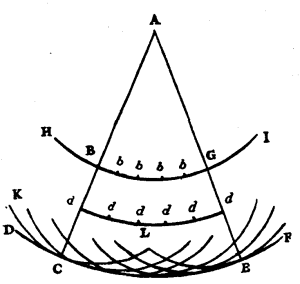The Emanation of These Waves
Table of Contents
Each particle of matter [2nd Element] in which a wave spreads communicates:
- its motion to the next particle ahead of it in a straight line from the luminous point
- some of its motion to all the others which touch it and which oppose themselves to its movement.
So around each particle is a wave with the centre in that particle.
DCF is a wave emanating from the center of luminous point A.
- The [2nd Element] particle
Bis part of waveDCF
It will make its partial wave KCL which will touch the wave DCF at C when the principal wave has arrived at DCF.

Only the region C of the wave KCL will touch the wave DCF as it is in the straight line through AB.
Similarly, the other particles of the sphere DCF, such as bb, dd, etc. will each make its own wave.
But each of these waves are infinitely feeble compared with the wave DCF which is composed of all the others.
- Those others contribute by the part of their surface which is most distant from the centre
A.
The wave DCF is determined by the distance attained in a certain space of time by the movement which started from the point A.
There is no movement beyond this wave. There will be movement in the space it encloses, namely in parts of the particular waves, those parts which do not touch the sphere DCF.
All the properties of Light, and everything pertaining to its reflexion and its refraction, can be explained by this.
The following had tried to prove the effects of reflexion and refraction by these waves:
- Hooke in his Micrographia
- Father Pardies
They did not know this principle.*
Superphysics Note
The Properties of Light
Each portion of a wave should spread in such a way that its extremities lie always between the same straight lines drawn from the luminous point.
Thus, the portion BG of the wave has the luminous point A as its centre. It will spread into the arc CE bounded by the straight lines ABC, AGE.
The waves produced by the particles within the space CAE spread also outside this space.
But they yet do not concur at the same instant to compose a wave which terminates the movement, as they do precisely at the circumference CE, which is their common tangent.
This is why light spreads only by straight lines.
If there were an opening BG, limited by opaque bodies BH, GI, the wave of light which issues from the point A will always be terminated by the straight lines AC, AE, as has just been shown.
The parts of the partial waves which spread outside the space ACE are too feeble to produce light there.
However small the opening BG is, the light will always pass through straight lines.
- This opening is always large enough to contain many particles of the ethereal matter which are of an inconceivable smallness.
- Each little portion of the wave necessarily advances following the straight line which comes from the luminous point.
Thus we may take the rays of light as if they were straight lines.
It appears, moreover, by what has been remarked touching the feebleness of the particular waves, that it is not needful that all the particles of the Ether should be equal amongst themselves, though equality is more apt for the propagation of the movement.
Inequality will cause a particle by pushing against another larger one to strive to recoil with a part of its movement. But it will thereby merely generate backwards towards the luminous point some partial waves incapable of causing light, and not a wave compounded of many as CE was.
One of the most marvellous property of waves of light is that when some of them come from different or even from opposing sides, they produce their effect across one another without any hindrance.
- Spectators may view different objects at the same time through the same opening
- Two persons can at the same time see one another’s eyes.
Now according to the explanation which has been given of the action of light, how the waves do not destroy nor interrupt one another when they cross one another, these effects which I have just mentioned are easily conceived.
But in my judgement they are not at all easy to explain according to the views of
Descartes says that Light consists of a continuous pressure merely tending to movement.
For this pressure not being able to act from 2 opposite sides at the same time, against bodies which have no inclination to approach one another, it is impossible so to understand what I have been saying about 2 persons mutually seeing one another’s eyes, or how two torches can illuminate one another.